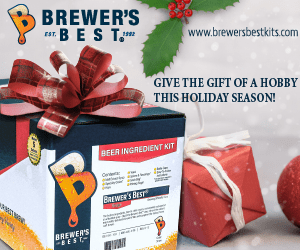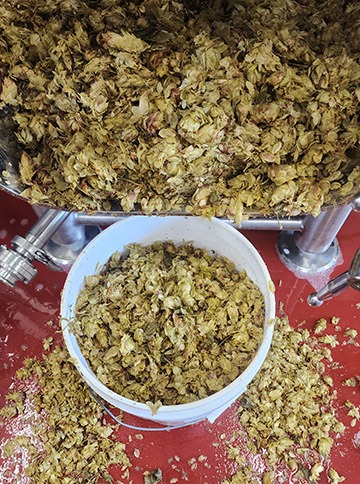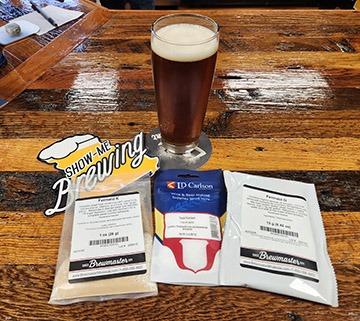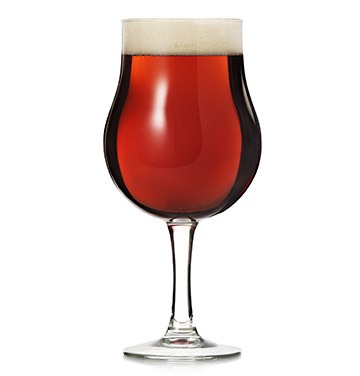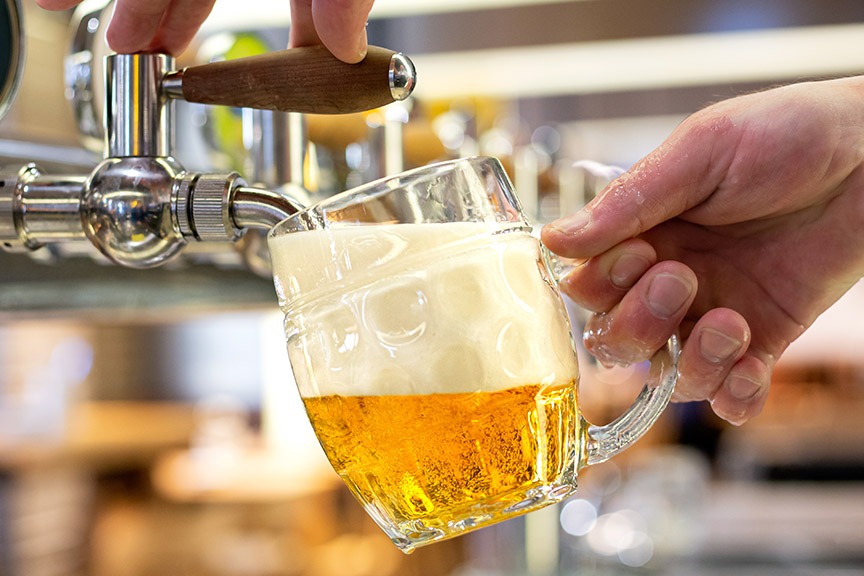Pumpkin Beer Tips & Clone Recipes

“Drip…drip…drip.”
I only had 2 ounces (57 g) of rice hulls in my grain bag while brewing my second-ever pumpkin beer. In hindsight, I should have ditched the plan, but at 10 p.m., and with pumpkins already baked, I was mentally ready to go through with the brew. But with the sparge going at less than a snail’s pace, I realized I was in for a long night.
I was about a half gallon (2 L) into the sparge phase of my fall brew and things were going smoothly. It was my second attempt at brewing a pumpkin beer. The first attempt had gone well on brew day (with 8 ounces/227 g of rice hulls), but a lack of judgment (and experience) when it came to spice additions resulted in a nutmeg bomb.
I first tried underletting (feeding water into the bottom of the mash tun) to unstick the sparge. It worked for a little while, and I was able to get another half gallon (2 L) before the “drip, drip” resumed. In order to clean the false bottom, I dumped the mash from my Igloo cooler into my old Zapap lauter tun and back again and restarted the vorlauf — yet it wasn’t long until I was back to “drip, drip.” Underletting the mash tun again, I got another gallon (4 L) out. Slowly but surely the sparge became unstuck as the sticky glucans drained.
When I was attempting this brew I was reading Randy Mosher’s book Radical Brewing, and I had latched onto his words with a passion. My first attempt at a pumpkin beer had been a blind attempt to clone the very first pumpkin beer I had ever tasted: Brooklyn Brewery Post Road Pumpkin Ale. With no guidance in the spicing department I created the aforementioned nutmeg disaster. A year later, thanks to Mr. Mosher’s book, I had a better sense of what to do with pumpkin beers. By 4:30 a.m. I finally pitched the yeast and had the first taste. Despite several hours of frustration and complete exhaustion, the base beer tasted solid.
Pumpkin Beer History
While to me, pumpkin beers started the day I tried Post Road Pumpkin way back in 1997, pumpkin — or pompion — beers actually have quite a storied history dating back to the colonial American period. Pumpkins are indigenous to North America. Seeds for pumpkins (Cucurbita maxima) have been carbon-dated to about 6000 BC in Mexico. Native Americans cut the pulp of pumpkins into strips to dry. Dried strips had a variety of uses including pulverizing them into flour; the strips could be eaten as food during long winters or strands were used for making baskets.
When the early English colonists landed in the New World keeping a steady supply of beer was considered a high priority in order to make them feel at home. It may not be in most schoolhouse history books, but the story goes that the Pilgrims made landfall at Plymouth Rock because their ale supply was running low.
In 17th century colonial North America, malt was extremely hard to come by on the western shores of the Atlantic Ocean. As a result colonists turned to a broad range of fruits, vegetables and sugars to ferment, in order to get a hard beverage. Hard cider from apples would have been quite popular due to the vigor with which apple trees adapted to the climate of the New World. Corn, ginger, and the sugars (like molasses and brown sugar) available to them were also utilized in abundance. Assorted squash including pumpkins were also quite popular as well. In what some claim to be the first American folk song “New England’s Annoyances,” from the early 1600s there is a satirical stanza about using pumpkin in beer and for food.
“Instead of pottage and puddings and custards and pies, Our pumpkins and parsnips are common supplies; We have pumpkin at morning and pumpkin at noon; If it was not for pumpkins we should be undone . . . Hey down, down, hey down derry down . . . If barley be wanting to make into malt We must be contented and think it no fault For we can make liquor, to sweeten our lips, Of pumpkins and parsnips and walnut-tree chips.”
Note that they make reference to parsnips and wood chips, but no mention of spices. Colonial Americans were in fact using spices to make several alcoholic concoctions such as metheglin (spiced mead) and spiced hard cider, as well as in their pumpkin custards, but I couldn’t find any reference to spices being used in pumpkin beers in those times. Several sources have uncovered the cocktail known as flip, which colonists mixed spiced rum with pumpkin beer and brown sugar. In The Oxford Companion to Beer, there is a reference to how colonists would produce the wort for a Pompion Ale (pumpkin beer):
“Let the pompion be beaten in a trough as apples. The expressed juice is to be boiled in a copper a considerable Time and carefully skimmed that there may be no remains of the fibrous part of the pulp. After that Intention is answered let the liquor be hopped cooled fermented as malt beer.”
The quote was first published in the American Philosophical Society in 1771. By the 1800s, grain production was offsetting the need to brew beers with pumpkin, and before long the use of pumpkins as an ingredient in beer died off.
Fast-forward almost 200 years to the American craft beer revolution. Bill Owens, founder of Buffalo Bill’s Brewery in Hayward, California, released the first of the modern renditions of pumpkin ale in 1985 after reading that George Washington used pumpkin to brew his pumpkin porter. Flavored with cinnamon, cloves, ginger and nutmeg, Buffalo Bill’s Pumpkin Ale was meant to be an amber ale with a hint of pumpkin pie character. Today, almost 30 years later, pumpkin beers have continued to evolve and now come in many forms. From light lagers to stouts, some with a subtle spice that is barely detectable until warmed, ranging up to the pumpkin pie in a glass, the age of pumpkin beers has returned.
Into the Brewhouse
So, how do you craft a pumpkin beer to your liking? Well, as with many broad-based questions the answer isn’t so simple. There are really at least three broad levels of complexity when crafting a pumpkin beer: The base beer, the pumpkin, and the spicing. As a brewer, you must learn to dial in each to achieve a symbiosis between the three. I talked with several professional brewers whose pumpkin beers span the range from subtle pumpkin beer to dessert pumpkin pie bliss in order to learn what they think it takes to get a masterful pumpkin beer.
Base Beer
Starting with the malts, hops, yeast, and water, homebrewers need to figure out a foundation for their beer. For a broad range of options in this category, look no further than the Seattle, Washington based Elysian Brewing Co. lineup of beers. Dick Cantwell and his team were pioneers in this department and put together more than 20 different pumpkin beers ranging from pale lagers to stouts to pumpkin sour blends to pumpkin hefeweizens. “As in the case of using a Bavarian hefeweizen yeast, the yeast itself can provide the spice,” Cantwell said. Step away from Elysian Brewing Co., and you’ll find that most pumpkin beers use a base beer more in line with an amber ale or Oktoberfest. Mild on the hops, moderate caramelly toasted flavors dominate the pumpkin beer world. There is a reason for this since this profile lends itself well to the concept of pumpkin pie and its associated spices. Wayne Wambles at Cigar City Brewing Co. in Tampa, Florida says they, “utilize neutral base malts, then layer in specialty and Munich malts to impart flavor, body, color, and sweetness. These malts are also a nice interlude into the toasted malts that are going to develop your pie crust flavors and aromas.”
After talking with several brewers I found that there is no right choice for yeast. Each brewer had his or her own opinion on where to go on this topic. Garrett Oliver from Brooklyn Brewery likes to use a more expressive English yeast to coax out some esters that play nicely with the caramel notes and spice found in this beer. Wayne Wambles likes a clean, neutral yeast that is at least moderately malty in order to let the malts be the centerpiece of their base beer. Cantwell uses everything from Brettanomyces, to hefeweizen strains, to blends soured with Lactobacillus.
As for hops, keep them subtle and low key. “You are basically just looking to offset the malt sweetness” said Chris Wilson, from Easton, Pennsylvania based Weyerbacher Brewing Co. “You don’t want the beer to be bitter or for the hop aromas to overpower the spice aromas, so we add all our hops at the beginning of the boil.” Keeping the IBUs below 25 is the consensus among the brewers I polled. The one exception was Hampton, New Hampshire’s Smuttynose Brewing Co. Brewmaster David Yarrington finds that, “. . . a bit of hop balance lets the drinker be aware they are still drinking a beer and not a dessert.”
Pumpkins
Pumpkins can be the biggest headache involved in brewing a pompion beer as I discussed in my opening. They’re high in sticky glucans and high in proteins and while they are not necessarily low in carbohydrates, it’s a challenge to get any fermentable extract from pumpkin flesh because of a high water content. These traits are great for a healthy diet, but for brewers they pose a challenge since it necessitates a large addition of pumpkin pulp in order to get much sugar contribution. In fact, if you add one pound (0.45 kg) of pumpkin pulp, you’ll get a modest boost of only about 0.005 to your starting gravity in a 5 gallon (19 L) batch.
For homebrewers, we have the option of roasting or boiling our own pumpkins to add into the beer. “If I was homebrewing, I’d roast up some real pumpkin meat with brown sugar” said David Yarrington of Smuttynose Brewing Co. Roasting the pumpkin can caramelize the sugars available and provide some character. Roast a pumpkin for one hour at 350 °F (177 °C) or until some browning appears and the entire pulp is soft, but not mushy. The timing of the roast will depend largely on the size of the pumpkins and will require you to monitor them to test for the right level.
So what pumpkins should you use? Again there is not much consensus here, but brewers that are using whole pumpkins instead of puree look for high-fiber varietals. I’ve always used pie pumpkins with the idea that they are more flavorful and contain more sugar than the larger pumpkins, but they also contain less fiber and will be more difficult to deal with in the mash.
A looming question though is when and how do we add the pumpkin to the beer? Mash, boil or fermenter? Since there is starch that can be converted to sugars, traditionally brewers have added the pumpkin to the mash to get conversion. But when the result is at best 0.005 additional points per pound, is adding all those gums to the mash really worth it? I found that while all the brewers I talked to added pumpkin in some form or other, there is no standard of when to add it. Some added it to the mash, some to the kettle, some to the fermenter; and in the case of Elysian Brewing Co., all three. Many brewers were just looking to get the classic carotene color from the pumpkins since pumpkins can add a slightly sour, astringent note. Most brewers normally shy away from adding an ingredient like this, but these are obviously not your ordinary brews.
There are plenty of ways to offset the gummy character the pumpkin provides if you plan to add the pumpkin to the mash. First is adding rice hulls, which helps break up the mash and create more pores in the sludge. Half a pound to a pound (0.23 to 0.45 kg) of rice hulls per 5-gallon (19-L) batch can be worth its weight in gold. Adding in a beta glucan rest at 122 °F (50 °C) for 15 minutes to help break those gums down is another helpful trick. Another tip is if you’re fly sparging, constantly rake the top of the mash as the gums rise to the top of the mash.
One thing the pros agreed upon is that the pumpkin addition doesn’t always seem to make or break the end product. The brewers I talked to were using between 0.5 lbs. (0.23 kg) pumpkin puree per barrel of wort and ranging up to 10 lbs. (4.5 kg) per barrel. Smuttynose adds on the lower end of the range while Weyerbacher Brewing adds on the higher end. Cigar City adds caramelized pumpkin puree to the fermenter while Brooklyn Brewery adds pumpkins to the mash. When I asked Garrett Oliver from Brooklyn Brewery how often they get a stuck sparge, he said, “never.” A protein rest plus proper mash out has worked for them despite the fact that their mash grist for Post Road Pumpkin Ale is about 10% pumpkin puree.
Spices
Finally we get to what may be the most controversial aspect of pumpkin beers: Spices. While some of you may want the golden ticket answer in this category, the fact is there is no one right answer as everyone has their own opinions on the subject. The best I can offer are suggestions of how to find the right mix to suit your own tastes. Traditional pumpkin pie spices rule the roost in the modern pumpkin beer world. Cinnamon, nutmeg, ginger, cloves, as well as allspice and vanilla, tend to dominate pumpkin beers. Many spice makers produce a pumpkin pie spice blend that can be a good starting point for homebrewers as well. Adjuncts such as brown sugar, molasses, maple syrup, and honey will also add some flavor into the mix. “Balancing the beer without overwhelming any singular aspect is our main goal. You should be able to pick up spice, the pumpkin, and the beer when you taste our pumpkin ale,” said Ryan McKeon, Brewery Production Manager at Otter Creek Brewing Co. in Middlebury, Vermont (which used to brew the Wolaver’s line of beers).
Everyone seems to have his or her own preference for what level of spicing is proper for a pumpkin ale. But if you’re going for a higher spice level in order to obtain a pumpkin pie in a glass experience, you’ll want to boost not only the final gravity of your base beer to increase the sweetness, but also boost the ABV so the ethanol can help balance the flavors. Ryan McKeon’s advice is to, “Make sure the base beer does not get lost. If you boost the spices, be sure to ramp up the base beer to keep a balance.”
Timing of the spice additions is very similar to timing of aroma hops additions. Many brewers try to keep the spice additions to very late in the boil or directly into the whirlpool on brew day. Something to consider is that if you can smell the aromas of the spices, the volatile oils are being driven off. Chris Wilson from Weyerbacher adds the spices with 2 minutes left in the boil in order to sanitize the spices, but not drive off much flavor and aroma. “We do get some of the spice into the fermenter which we find does not impact the final product,” he said.
Other brewers put the spices into the fermenter, much like dry hopping, with the idea that this will keep the most volatile oils in the beer. What I’ve done for years now is make tinctures from the spice additions. I originally learned of making tinctures from Randy Mosher in Radical Brewing. I make tinctures by soaking my spices in cheap vodka for about a week. The technique is fully outlined in Randy Mosher’s book, but the basics are that by using an eyedropper in a one ounce pour of the beer, you can scale the tincture up to your full batch size and add the correct level of the tincture just before bottling or kegging. If you feel like tinctures are too much of a hassle, you can start off trying one of the clone recipes found below, to get your feet wet. If your beer has too little or too much of a certain spice, make the necessary adjustments for the next batch. If you do decide to experiment with spices, be sure to err on the side of caution. You can always add more, but you can’t take the spice out.
Pour your Pumpkin Beers
Pumpkin beers have come a long way since the days of Colonial America. My second pumpkin beer turned out to be a huge success despite the hair pulling on brew day. I’ll always remember that batch since it was my first “extreme” beer that had gone right. Best of luck in crafting a pompion beer of your own!
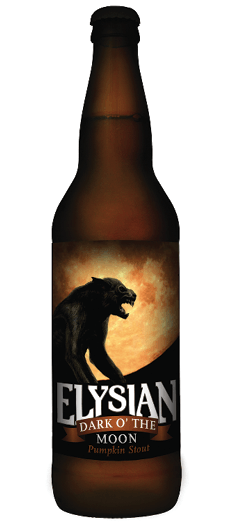
Elysian Brewing Company Dark o’ the Moon clone
(5 gallons/19 L, all-grain)
OG = 1.072 FG = 1.022 IBU = 25 SRM = 56 ABV = 6.5%
Ingredients
- 11 lbs. (5 kg) Great Western 2-row pale malt (or similar)
- 1.25 lbs. (0.57 kg) Weyermann Munich malt (9 °L)
- 1 lb. (0.45 kg) Crisp roasted barley (550 °L)
- 1 lb. (0.45 kg) Crisp chocolate malt (450 °L)
- 8 oz. (0.23 kg) Crisp crystal malt (77 °L)
- 8 oz. (0.23 kg) Castle Château Cara Ruby™ (20 °L)
- 5 oz. (0.14 kg) Special B malt (114 °L)
- 8 oz. (0.23 kg) pumpkin puree (mash addition)
- 8 oz. (0.23 kg) pumpkin puree (kettle addition) (90 min.)
- 5.3 AAU Magnum hops (60 min.) (0.4 oz./11 g at 13.5% alpha acids)
- 4 AAU Saaz hops (2 min.) (1 oz./28 g at 4% alpha acids)
- 0.25 oz. (7 g) Vietnamese ground cinnamon (5 min.)
- 0.125 oz. (3.5 g) Vietnamese ground cinnamon (0 min.)
- 0.125 oz. (3.5 g) Vietnamese ground cinnamon (secondary)
- 5.3 oz. (0.15 kg) pumpkin puree (fermenter addition)
- Wyeast 1056 (American Ale) or White Labs WLP001 (California Ale) or Lallemand BRY-97 (American West Coast Beer) or Fermentis US-05 yeast
- Priming sugar (if bottling)
Step by Step
Elysian uses three additions of pumpkin puree: 40% added to the mash, 40% added to the kettle, and 20% to the fermenter. The last two additions must be thinned with wort as pumpkin can lower starting gravities. To do this, draw some wort off into the pumpkin puree and mix until suspended.
Heat 5 gallons (19 L) of strike water to achieve a stable mash temperature of 154 °F (68 °C). Hold at this temperature until starch conversion is complete. Collect at least 6.5 gallons (25 L) wort in the kettle along with the kettle addition of thinned pumpkin puree and boil for 90 minutes adding hops, pumpkin puree, and cinnamon at the times indicated.
After boil, stir the wort for at least a minute and let it settle for 15 minutes total. Chill the wort to 70 °F (21 °C) and maintain this temperature during active fermentation. Add the final addition of thinned pumpkin puree to the fermenter once the primary fermentation begins to slow down. After allowing time for suspended material to settle, rack to a secondary vessel and add the final addition of cinnamon. Let the beer sit for a week then bottle or keg.
Elysian Brewing Company Dark o’ the Moon clone
(5 gallons/19 L, extract with grains)
OG = 1.072 FG = 1.022 IBU = 25 SRM = 56 ABV = 6.5%
Ingredients
- 4 lbs. (1.8 kg) extra light dried malt extract
- 3.3 lbs. (1.5 kg) liquid Munich malt extract
- 1 lb. (0.45 kg) Crisp roasted barley (550 °L)
- 1 lb. (0.45 kg) Crisp chocolate malt (450 °L)
- 8 oz. (0.23 kg) Crisp crystal malt (77 °L)
- 8 oz. (0.23 kg) Castle Château Cara Ruby™ (20 °L)
- 5 oz. (0.14 kg) Special B malt (114 °L)
- 8 oz. (0.23 kg) pumpkin puree (mash addition)
- 8 oz. (0.23 kg) pumpkin puree (kettle addition) (60 min.)
- 5.3 AAU Magnum hops (60 min.) (0.4 oz./11 g at 13.5% alpha acids)
- 4 AAU Saaz hops (2 min.) (1 oz./28 g at 4% alpha acids)
- 0.25 oz. (7 g) Vietnamese ground cinnamon (5 min.)
- 0.125 oz. (3.5 g) Vietnamese ground cinnamon (0 min.)
- 0.125 oz. (3.5 g) Vietnamese ground cinnamon (secondary)
- 5.3 oz. (0.15 kg) pumpkin puree (fermenter addition)
- Wyeast 1056 (American Ale) or White Labs WLP001 (California Ale) or Lallemand BRY-97 (American West Coast Beer) or Fermentis US-05 yeast
- Priming sugar (if bottling)
Step by Step
The easiest way to brew this is with liquid Munich malt extract, but a partial mash is a good option and would allow the starch in the pumpkin puree to convert to simple sugars. If using a partial mash, allow conversion to occur before adding the bulk of the darker roasted grains as you may negatively affect the mash pH, hurting the enzymes’ ability to convert the starch of the mash.
Heat 2 gallons (7.8 L) water to 170 °F (77 °C) and place crushed grains and pumpkin puree in a brewing bag. Soak the grains for 20 minutes at 160 °F (71 °C), then rinse the grains with 1 gallon (3.8 L) of hot water. Collect 6 gallons (23 L) of wort and pumpkin puree in the kettle and add the liquid and dried malt extract off the heat. Stir until all the extract has dissolved. Bring the wort to a boil for 60 minutes adding hops, pumpkin puree and cinnamon at the times indicated in the recipe. Now follow the remainder of the all-grain recipe.
Weyerbacher Brewing Co. Imperial Pumpkin Ale clone

(5 gallons/19 L, all-grain)
OG = 1.080 FG = 1.019 IBU = 21 SRM = 13 ABV = 8%
Ingredients
- 7.6 lbs. (3.5 kg) Muntons pale ale malt (2.5 °L)
- 5.25 lbs. (2.4 kg) Weyermann Vienna malt (3.5 °L)
- 1.8 lbs. (0.8 kg) Weyermann Munich I malt (6 °L)
- 1.8 lbs. (0.8 kg) Weyermann CaraMunich® II (45 °L)
- 0.9 lbs. (0.4 kg) Weyermann CaraFoam® (2 °L)
- 6.3 AAU Apollo hop pellets (60 min.) (0.35 oz./10 g at 18% alpha acids)
- 1.6 lbs. (0.7 kg) pumpkin puree (10 min.)
- 0.38 oz. (10.6 g) Vietnamese ground cinnamon (2 min.)
- 0.2 oz. (5.7 g) ground nutmeg (2 min.)
- 1 pinch ground cardamom (2 min.)
- 1 pinch ground clove (2 min.)
- Wyeast 1272 (American Ale II) or White Labs WLP051 (California Ale V) or Lallemand Nottingham ale yeast
- Priming sugar (if bottling)
Step by Step
Heat 5.5 gallons (20.5 L) of strike water to achieve a stable mash temperature of 144 °F (62 °C). Hold at this temperature until starch conversion is complete, which is at least 60 minutes. Check for complete conversion using an iodine test before beginning the sparge phase.
Collect 6 gallons (23 L) of wort in the kettle and boil for 60 minutes adding hops at the beginning of the boil. Weyerbacher uses a high alpha acid hop variety to keep vegetal matter to a minimum considering the amount of pumpkin to follow. They do not use any aroma additions and therefore just let the spices define the aroma. Add the spices with 2 minutes left in the boil. The pumpkin puree is added directly into the kettle to avoid the stuck mash issue. This means that the yield will be affected downstream as more beer will be lost at each transfer point. Weyerbacher reports that they lose a significant amount of wort in the fermenter. Be careful not to add too much of either the cardamom or the clove as they can easily overwhelm the beer.
After the boil, give the wort a stir for at least a minute and let the hot wort settle for 15 minutes total. Chill the wort to 68 °F (20 °C) and maintain this temperature during active fermentation. If you can, ramp the temperature up to 72 °F (22 °C) at the end of active fermentation to assure completion. Rack the beer to a keg and force carbonate, or rack to a bottling bucket, add priming sugar, and bottle.
Weyerbacher Brewing Co. Imperial Pumpkin Ale clone
(5 gallons/19 L, extract with grains)
OG = 1.080 FG = 1.019 IBU = 21 SRM = 13 ABV = 8%
Ingredients
- 9.5 lbs. (4.3 kg) Munich liquid malt extract
- 1.8 lbs. (0.8 kg) Weyermann CaraMunich® II (45 °L)
- 0.9 lbs. (0.4 kg) Weyermann CaraFoam® (2 °L)
- 6.3 AAU Apollo hop pellets (60 min.) (0.35 oz./10 g at 18% alpha acids)
- 1.6 lbs. (0.7 kg) pumpkin puree (10 min.)
- 0.38 oz. (10.6 g) Vietnamese ground cinnamon (2 min.)
- 0.2 oz. (5.7 g) ground nutmeg (2 min.)
- 1 pinch ground cardamom (2 min.)
- 1 pinch ground clove (2 min.)
- Wyeast 1272 (American Ale II) or White Labs WLP051 (California Ale V) or Lallemand Nottingham ale yeast
- Priming sugar (if bottling)
Step by Step
Heat 1 gallon (3.8 L) of water to 170 °F (77 °C) and place the crushed grains in a brewing bag. Soak the grains for 20 minutes at 160 °F (71 °C), then rinse the grains with 1 gallon (3.8 L) of hot water. Do not squeeze the bag — let it drip into the kettle.
Collect 6 gallons (23 L) of wort in the kettle and add the liquid malt extract off the heat. Stir until all the extract has dissolved. Bring the wort to a boil for 60 minutes adding the hops at the beginning of the boil. Weyerbacher uses a high alpha acid hop variety to keep vegetal matter to a minimum considering the amount of pumpkin to follow. We do not use any aroma additions and therefore just let the spices define the aroma. Add the spices with 2 minutes left in the boil. The pumpkin puree is added directly into the kettle to avoid the stuck mash issue. This means that the yield will be affected downstream as more beer will be lost at each transfer point. Weyerbacher reports that they lose a significant amount of wort in the fermenter. Be careful not to add too much of either the cardamom or the clove as they can easily overwhelm the beer.
After the boil, give the wort a stir for at least a minute and let the hot wort settle for 15 minutes total. Chill the wort to 68 °F (20 °C) and maintain this temperature during active fermentation. If you can, ramp the temperature up to 72 °F (22 °C) at the end of active fermentation to assure completion. Rack the beer to a keg and force carbonate, or rack to a bottling bucket, add priming sugar, and bottle.

Smuttynose Brewing Co. Pumpkin Ale clone
(5 gallons/19 L, all-grain)
OG = 1.057 FG = 1.012 IBU = 35 SRM = 8 ABV = 6.1%
“This beer was designed to have some nice sweetness created by a mix of caramel malts and we wanted a decent hop presence as well. Over the years we’ve reduced the amount of cloves we’ve added as that one spice always seems to be the one to throw things out of balance. If I was brewing this at home I’d go easy on the clove and add more in later batches if needed.” ~ David Yarrington, Brewmaster
Ingredients
- 10.75 lbs. (4.9 kg) 2-row pale malt
- 0.9 lbs. (0.41 kg) Hugh Bairds light Carastan malt (15 °L)
- 4 oz. (0.11 kg) crystal malt (60 °L)
- 4 oz. (0.11 kg) pumpkin puree
- 5.5 AAU Cascade hops (75 min.) (1 oz./28 g at 5.5% alpha acids)
- 4.1 AAU Cascade hops (10 min.) (0.75 oz./21 g at 5.5% alpha acids)
- 3.4 AAU Liberty hops (0 min.) (0.75 oz./21 g at 4.5% alpha acids)
- 0.14 oz. (4 g) ground cinnamon (0 min.)
- 0.14 oz. (4 g) ground nutmeg (0 min.)
- 1 pinch ground clove (0 min.)
- Wyeast 1056 (American Ale) or White Labs WLP001 (California Ale) or Lallemand BRY-97 (American West Coast Beer) or Fermentis US-05 yeast
- Priming sugar (if bottling)
Step by Step
Heat 4 gallons (15 L) of strike water to achieve a stable mash temperature of 155 °F (68 °C). Add the crushed grains and the pumpkin puree in the mash and hold at 155 °F (68 °C) until starch conversion is complete. Be sure to check for complete conversion using an iodine test before beginning the sparge phase.
Collect 6.25 gallons (24 L) of wort in the kettle and boil for 75 minutes, adding hops at the beginning of the boil and again with 10 minutes left in the boil. At flameout, add the final addition of hops and spices. Give the wort a stir for at least a minute and let the hot wort settle for 15 minutes total. Chill the wort rapidly to 68 °F (20 °C) and pitch the yeast. Maintain this temperature during active fermentation.
Rack the finished beer to a keg and force carbonate, or rack to a bottling bucket, add priming sugar, and bottle.
Smuttynose Brewing Co. Pumpkin Ale clone
(5 gallons/19 L, extract with grains)
OG = 1.057 FG = 1.012 IBU = 35 SRM = 8 ABV = 6.1%
Ingredients
- 5.75 lbs. (2.6 kg) extra light dried malt extract
- 0.9 lbs. (0.41 kg) Hugh Bairds light Carastan malt (15 °L)
- 4 oz. (0.11 kg) crystal malt (60 °L)
- 4 oz. (0.11 kg) pumpkin puree
- 5.5 AAU Cascade hops (75 min.) (1 oz./28 g at 5.5% alpha acids)
- 4.1 AAU Cascade hops (10 min.) (0.75 oz./21 g at 5.5% alpha acids)
- 3.4 AAU Liberty hops (0 min.) (0.75 oz./21 g at 4.5% alpha acids)
- 0.14 oz. (4 g) ground cinnamon (0 min.)
- 0.14 oz. (4 g) ground nutmeg (0 min.)
- 1 pinch ground clove (0 min.)
- Wyeast 1056 (American Ale) or White Labs WLP001 (California Ale) or Lallemand BRY-97 (American West Coast Beer) or Fermentis US-05 yeast
- Priming sugar (if bottling)
Step by Step
Heat 1 gallon (3.8 L) of water to 170 °F (77 °C) and place the crushed grains and the pumpkin puree in a brewing bag. Soak the grains and puree for 20 minutes at 160 °F (71 °C), then rinse the bag with 1 gallon (3.8 L) of hot water. Do not squeeze the brewing bag — allow it to drip back into the kettle.
Top off the kettle to make 6.25 gallons (24 L) wort and boil for 75 minutes. Add the hops at the beginning of the boil and again with 10 minutes left in the boil. At flameout, add the final addition of hops and spices.
Give the wort a stir for at least a minute and let the hot wort settle for 15 minutes total. Chill the wort rapidly to 68 °F (20 °C) and pitch the yeast. Maintain this temperature during active fermentation.
Rack the finished beer to a keg and force carbonate, or rack to a bottling bucket, add priming sugar, and bottle.
Tips for Success
In the all-grain recipe, use 0.5 lb. to 1 lb. (0.23 to 0.45 kg) of rice hulls per 5-gallons (19-L) to prevent a slow or stuck sparge. You can also add a beta glucan rest at 122 °F (50 °C) for 15 minutes at the beginning of the mash.

Wolaver’s Organic Brewing Pumpkin Ale clone
(5 gallons/19 L, all-grain)
OG = 1.057 FG = 1.016 IBU = 20 SRM = 9 ABV = 5.4%
“We source our pumpkins from a pumpkin grower just a few miles down the road. We are looking for a balance between malts, hops and a mild spice character.” ~ Ryan McKeon, Brewery Production Manager
Ingredients
- 9 lbs. (4.1 kg) organic 2-row pale malt
- 2.5 lbs. (1.13 kg) organic Munich malt (10 °L)
- 10 oz. (0.27 kg) organic crystal malt (60 °L)
- 4 oz. (0.11 kg) organic pumpkin puree
- 2.2 AAU organic Perle hops (60 min.) (0.25 oz./78 g at 8.6% alpha acids)
- 3.4 AAU organic Perle hops (15 min.) (0.4 oz./11 g at 8.6% alpha acids)
- 3.4 AAU organic Perle hops (0 min.) (0.4 oz./11 g at 8.6% alpha acids)
- 0.14 oz. (4 g) ground cinnamon (0 min.)
- 0.14 oz. (4 g) ground ginger (0 min.)
- 0.05 oz. (1.4 g) ground nutmeg (0 min.)
- 0.05 oz. (1.4 g) ground cloves (0 min.)
- Wyeast 1056 (American Ale) or White Labs WLP001 (California Ale) or Lallemand BRY-97 (American West Coast Beer) or Fermentis US-05 yeast
- Priming sugar (if bottling)
Step by Step
Heat 3.75 gallons (14 L) of strike water to achieve a stable mash temperature of 154 °F (68 °C). Add the crushed grains and pumpkin puree in the mash and hold at 154 °F (68 °C) for 60 minutes, then ramp mash temperature up to 170 °F (77 °C) for mash out and hold for 5 minutes.
Collect 6 gallons (23 L) of wort in the kettle and boil for 60 minutes, adding hops at the beginning of the boil and again with 15 minutes left in the boil. At flameout, add the final addition of hops and spices. Give the wort a stir for at least a minute and let the hot wort settle for 15 minutes total.
Chill the wort rapidly to 68 °F (20 °C) and pitch the yeast. Maintain this temperature during active fermentation. Rack to a keg and force carbonate or rack to a bottling bucket, add priming sugar, and bottle.
Wolaver’s Organic Brewing Pumpkin Ale clone
(5 gallons/19 L, extract with grains)
OG = 1.057 FG = 1.016 IBU = 20 SRM = 9 ABV = 5.4%
Ingredients
6.25 lbs. (2.8 kg) organic light liquid malt extract
2.5 lbs. (1.13 kg) organic Munich malt (10 °L)
10 oz. (0.27 kg) organic crystal malt (60 °L)
4 oz. (0.11 kg) organic pumpkin puree
2.2 AAU organic Perle hops (60 min.) (0.25 oz./78 g at 8.6% alpha acids)
3.4 AAU organic Perle hops (15 min.) (0.4 oz./11 g at 8.6% alpha acids)
3.4 AAU organic Perle hops (0 min.) (0.4 oz./11 g at 8.6% alpha acids)
0.14 oz. (4 g) ground cinnamon (0 min.)
0.14 oz. (4 g) ground ginger (0 min.)
0.05 oz. (1.4 g) ground nutmeg (0 min.)
0.05 oz. (1.4 g) ground cloves (0 min.)
pinch ground clove (0 min.)
Wyeast 1056 (American Ale) or White Labs WLP001 (California Ale) or Lallemand BRY-97 (American West Coast Beer) or Fermentis US-05 yeast
Priming sugar (if bottling)
Step by Step
Heat 1.5 gallons (5.7 L) water to 165 °F (74 °C) and place the crushed grains and pumpkin puree in a brewing bag. Soak the grains and puree for 40 minutes at 155 °F (68 °C), then rinse the bag with 1 gallon (3.8 L) of hot water. Do not squeeze the bag — allow it to drip back into the kettle.
Top off kettle to 6 gallons (23 L) wort and boil for 60 minutes, adding hops at the beginning of the boil and again with 15 minutes left in the boil. At flameout, add the final addition of hops and spices. Give the wort a stir for at least a minute and let the hot wort settle for 15 minutes total.
Chill the wort rapidly to 68 °F (20 °C) and pitch the yeast. Maintain this temperature during active fermentation. Rack to a keg and force carbonate or rack to a bottling bucket, add priming sugar, and bottle.
Tips for Success
In the all-grain recipe, use 0.5 lb. to 1 lb. (0.23 to 0.45 kg) of rice hulls per 5-gallons (19-L) to prevent a slow or stuck sparge. You can also add a beta glucan rest at 122 °F (50 °C) for 15 minutes at the beginning of the mash.
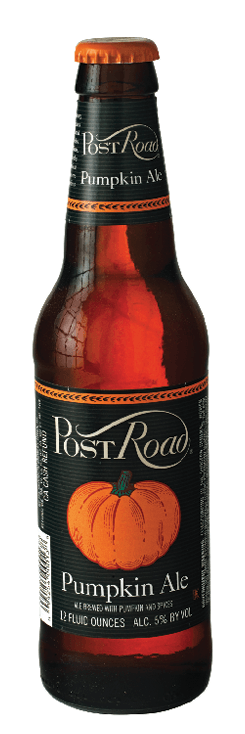
Brooklyn Brewery Post Road Pumpkin Ale clone
(5 gallons/19 L, all-grain)
OG = 1.055 FG = 1.013 IBU = 24 SRM = 10 ABV = 5.6%
Ingredients
- 9.75 lbs. (4.4 kg) North American 2-row pale malt
- 1 lb. (0.45 kg) British crystal malt (55 °L)
- 6 oz. (0.17 kg) Belgian biscuit malt (20 °L)
- 6 oz. (0.17 kg) Belgian aromatic malt (25 °L)
- 1.2 lbs. (0.54 kg) Dickinson pumpkins pureed
- 5 AAU US Fuggles hops (60 min.) (1 oz./28 g at 5% alpha acids)
- 1.3 AAU US Fuggles hops (15 min.) (0.25 oz./7 g at 5% alpha acids)
- 1.3 AAU Willamette hops (15 min.) (0.25 oz./7 g at 5.2% alpha acids)
- 0.2 oz. (6 g) ground cinnamon (0 min.)
- 0.2 oz. (6 g) ground ginger (0 min.)
- 0.1 oz. (3 g) ground nutmeg (0 min.)
- Wyeast 1028 (London Ale) or White Labs WLP013 (London Ale) or Lallemand Nottingham yeast
- Priming sugar (if bottling)
Step by Step
Heat 3.75 gallons (14 L) strike water to achieve a stable mash temperature of 158 °F (70 °C). Add crushed grains and pumpkin puree in the mash and hold at 158 °F (70 °C) for 60 minutes, then ramp mash temperature up to 170 °F (77 °C) for mash out and hold for 5 minutes.
Collect 6 gallons (23 L) wort in the kettle and boil for 60 minutes adding hops at the beginning of the boil and again with 15 minutes left in the boil. At flameout add the spices then give the wort a stir for at least a minute and let the hot wort settle for 15 minutes total. Chill the wort to 68 °F (20 °C) and maintain this temperature during active fermentation. Rack to a keg and force carbonate or rack to a bottling bucket, add priming sugar, and bottle.
Brooklyn Brewery Post Road Pumpkin Ale clone
(5 gallons/19 L, extract with grains)
OG = 1.055 FG = 1.013 IBU = 24 SRM = 10 ABV = 5.6%
Ingredients
- 6 lbs. (2.7 kg) extra light liquid malt extract
- 1 lb. (0.45 kg) North American 2-row pale malt
- 1 lb. (0.45 kg) British crystal malt (55 °L)
- 6 oz. (0.17 kg) Belgian biscuit malt (20 °L)
- 6 oz. (0.17 kg) Belgian aromatic malt (25 °L)
- 1.2 lbs. (0.54 kg) Dickinson pumpkins pureed
- 5 AAU US Fuggles hops (60 min.) (1 oz./28 g at 5% alpha acids)
- 1.3 AAU US Fuggles hops (15 min.) (0.25 oz./7 g at 5% alpha acids)
- 1.3 AAU Willamette hops (15 min.) (0.25 oz./7 g at 5.2% alpha acids)
- 0.2 oz. (6 g) ground cinnamon (0 min.)
- 0.2 oz. (6 g) ground ginger (0 min.)
- 0.1 oz. (3 g) ground nutmeg (0 min.)
- Wyeast 1028 (London Ale) or White Labs WLP013 (London Ale) or Lallemand Nottingham yeast
- Priming sugar (if bottling)
Step by Step
Heat 1.5 gallons (5.7 L) water to 170 °F (77 °C) and place crushed grains and pumpkin puree in a bag. Soak the grains and puree for 60 minutes at 158 °F (70 °C), then rinse the bag with 1 gallon (3.8 L) of hot water.
Top off kettle to 6 gallons (23 L) wort in the kettle and boil for 60 minutes adding hops at the beginning of the boil and again with 15 minutes left in the boil. At flameout, add the the spices then give the wort a stir for at
least a minute and let the hot wort settle for 15 minutes total. Chill the wort to 68 °F (20 °C) and maintain this temperature during active fermentation. Rack to a keg and force carbonate or rack to a bottling bucket, add priming sugar, and bottle.
Tips for Success
In the all-grain recipe, use 0.5 lb. to 1 lb. (0.23 to 0.45 kg) of rice hulls per 5-gallons (19-L) to prevent a slow or stuck sparge. You can also add a beta glucan rest at 122 °F (50 °C) for 15 minutes at the beginning of the mash.

